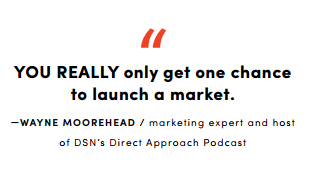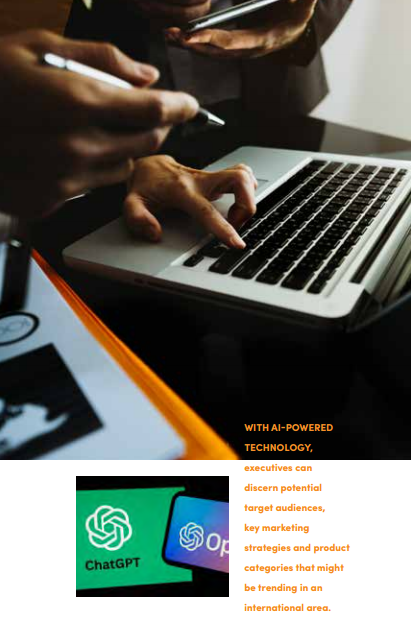
Identifying and understanding market opportunities around the world.
Taking a brand international is a big step for any company. New markets mean new customers, expanded audiences and unique opportunities to try out products that might not be a fit for the original hometown fans. Not to mention, exposure to new cultures and ways of life can be inspirational for product development teams eager to serve the needs and wants of new demographics. Gaining ground internationally can add revenue and stockholder value and build traction abroad that can bolster the domestic team when sales at home turn stagnant. These benefits come at a steep cost, however, for brands who don’t do their homework.
“You really only get one chance to launch a market,” said Wayne Moorehead, marketing expert and host of DSN’s Direct Approach Podcast. “If you don’t launch it right, a lot of times you can’t swing back around to fix it. You have to walk away for a while and let the dust settle.”
Ex-Pats Provide Added Value
Building a global brand name that carries an honorable reputation and a healthy balance sheet requires commitment, staying power and an understanding of the unique expectations and regulations within each country and specific region. What’s more, brands need to have an appreciation and respect for the local culture and take into account how their presence could have a positive or negative impact on the people there. That means investing in local talent who can serve as a boots-on-the-ground guide for the home office, while also skillfully leading the international headquarters.

doTERRA Chief Executive Officer Cory Lindley points to the importance of having a home office leadership presence in newly planted markets to synthesize the brand’s mission and values with the needs and ideas of international satellite locations. This is a vital component to a healthy international launch. Investing in an ex-pat is an expense that many companies tend to shy away from, Lindley says, but sending them to help launch the brand abroad, then supporting them when they repatriate, is a key component to doTERRA’s global expansion success.
“Now, our office back here at corporate after 15 years is full of people who have lived and worked in various markets around the world and who understand the cultural sensitivities and how to support those markets,” he said.
Five Global Market Opportunities
As executives consider making the leap into new international markets, Direct Selling News considered five regions—North America, South America, Africa, Asia and Europe—to assess the opportunities and challenges presented in each, taking into account the trends, dynamics and statistics provided by the 2022 World Federation of Direct Selling Associations (WFDSA) annual publication.
1 / North America
The United States continues to be the largest direct selling market opportunity in the world. Last year, direct selling in the US brought in sales exceeding $40 billion, an amount that represented almost two-thirds (62%) of all sales in both North and South America combined and just shy of a quarter (23%) of sales worldwide.
For companies founded in the US, having a healthy customer base domestically may seem obvious, but it is an essential ingredient to an international strategy.

“You need to have a strong US presence,” Lindley said. “So many companies run international before they’ve really strengthened their home market presence. You have to be successful in your home market. doTERRA operates around the globe, but the US is still by far our largest market and twice as big as any international market for us.”
In Canada, where revenues reached $2.5 billion in 2022, the opportunity is similarly inviting and one that Direct Selling Association (DSA) Canada President Peter Maddox describes as very similar to the US.
“Canada is a consistent and strongly performing direct selling opportunity and will reward companies that prepare well and operate ethically,” Maddox explained. “As with many other markets around the world, Canadians are seeking extra income to counter the effects of high interest rates, high inflation and stagnating wages—direct selling is perfectly positioned to capitalize on this need.”
The Canadian market has a relatively high regulatory requirement, and Maddox cautions leaders to pre-plan their entry and to tap into local expertise to avoid pitfalls, including the complex logistics of serving a relatively small population (40 million people) across a vast landmass.

In 2024, Maddox predicts Canadians will be eager to embrace the use of video live shopping tools and affiliate and influencer programs, but advises US companies against the temptation to copy and paste their product lines into a Canadian launch.
“Although there are similar tastes and expectations, entering Canada with the same products and marketing as those utilized in the US rarely works well,” Maddox said. “Some level of Canadian-ization is recommended.”

2 / South America
As in the US and many other markets, ecommerce giants like Amazon (Mercado Livre) have provided significant competition for independent distributors in South America, resulting in flat sales for Brazil, the second-largest market in the Americas.
There were standout countries, like Argentina, a region that saw a 58 percent increase in 2022 over 2021. This boost must be tempered, however, with the fact that inflation in the area was near 100 percent as well. Colombia, Peru and Argentina all saw sales exceeding $1 billion and local experts say that distributors who are willing to branch out into relying on digital tools and embrace a new way of reaching audiences will see more success than those who do not. Similarly, companies who support their distributors through smart supply chain management and on-time product delivery fare far better than competitors who put this region on the back burner.
3 / Europe
For companies looking to establish or grow their presence in Europe, Jerome Freytag, a consultant for direct selling companies in Europe, says France should be the most logical next step. Although the country holds a complex regulatory environment, France’s legal ecosystem is generally favorable toward direct selling, and the DSA in France (Federation de la Vente Directe, or FVD) is a powerful resource for newcomers.

“France has the strongest DSA in the world, with 130 members,” Freytag said. “It is a great place to share best practices and learn fast. The team at FVD do a fantastic job promoting the industry.”
There are a number of peculiarities about working in the direct spelling space in France, including the requirement of a specific status called Vendeur à Domicile Indépendant, or VDI, which requires direct selling companies to be in charge of applicable tax withholdings for their independent contractors. But even this complexity has a benefit in that it is an attractive recruiting tool.
“While French direct selling companies attract a lot of distributors, they are immature on numerous aspects,” he said. “Companies from abroad will likely outperform them.”
As for what products are expected to be hot in France in 2024, Freytag says travel services, CBD-infused products and nail art top the list.

4 / Asia
The Asia Pacific region is a billion-dollar market powerhouse, boasting almost half of all billion-dollar markets in the world. Overall, this region saw estimated retail sales of $71.5 billion in 2022, of which South Korea and China make up a significant portion.
“Asia is a significant part of our business currently and will continue to be a growing part of our strategy moving forward. Asia remains one of the most robust and fastest growing regions in the world for direct selling. We plan to continue to play a big part in this growth,” shared Rod Taylor, CEO of New Image International.
These markets are not without challenges and the lingering effects of the pandemic and government-enforced lockdowns led to eight of the region’s markets to decline last year. China, in particular, saw an eight percent decline last year, with retail sales reaching $15.8 billion.
5 / Africa
While the continent of Africa is not home to any billion-dollar markets, overall, Africa and the Middle East experienced retail sales of $1.4 billion dollars. The last few years have been difficult for the region and sales were down by 13.3 percent, but local experts believe the horizon for the region is full of opportunity.

“Direct selling is still relatively new in the African market,” said Vivian Mokome, entrepreneur, founder and global speaker in South Africa. “It is only now that people are slowly warming up to the business model. We now have numbers that show the model works, and Africans are generally aggressive when it comes to an idea that is working.”
Mokome points to Nigeria and South Africa as being particularly receptive to the direct selling opportunity, and products in the categories of skin care and weight loss are moving well. The challenge in this region has more to do with logistics, customs and shipping issues creating significant road blocks. Once established, however, these obstacles subside.
“The regulations are not as strict in comparison with Europe and America,” Mokome said. “And we have numbers here: six out of ten people are living in poverty. Young people are unemployed and looking for job opportunities. Direct selling is a real option for them.”

AI-Powered Launches
Getting the details right can sound daunting, and while an international branch is not a project to take on lightly, there are new digital hacks that can help lower cost and risk. With AI-powered technology, executives can discern potential target audiences, key marketing strategies and product categories that might be trending in an international area. One quick search in ChatGPT can generate product pitches in a brand-specific voice translated for international markets or deliver information regarding regulatory laws in unfamiliar regions.
For instance, a ChatGPT search asking if CBD products would sell well in South Korea returns information about stringent laws surrounding the level of THC in products; import/export regulations; and important licenses and permits necessary for distributors. In one minute, executives have crucial information about the barriers to entry for free. Add to that AI-backed resources like Craiyon, a free AI image generator, and executives can create stock imagery for international markets without ever leaving the home office.
International Staying Power

Every unique culture deserves its own customized launch, and there is no one-size-fits-all approach or guidebook for opening up in a new market. That’s why it’s critical to make the effort beforehand to understand the nuances of a location before making the leap. And while AI can smooth that process and even make it more cost-effective, there are no shortcuts for long-term commitments.
“A key element for us to be able to succeed globally is that we take a long-term approach,” Lindley said. “We’re not the same level of success in every market around the world, but once we enter, we’re there for the long-term. I think that’s the attitude you need to take. Are you ready to stand behind this for the long-term? If not, you really shouldn’t be going to that market.”
From the October 2023 issue of Direct Selling News magazine.


